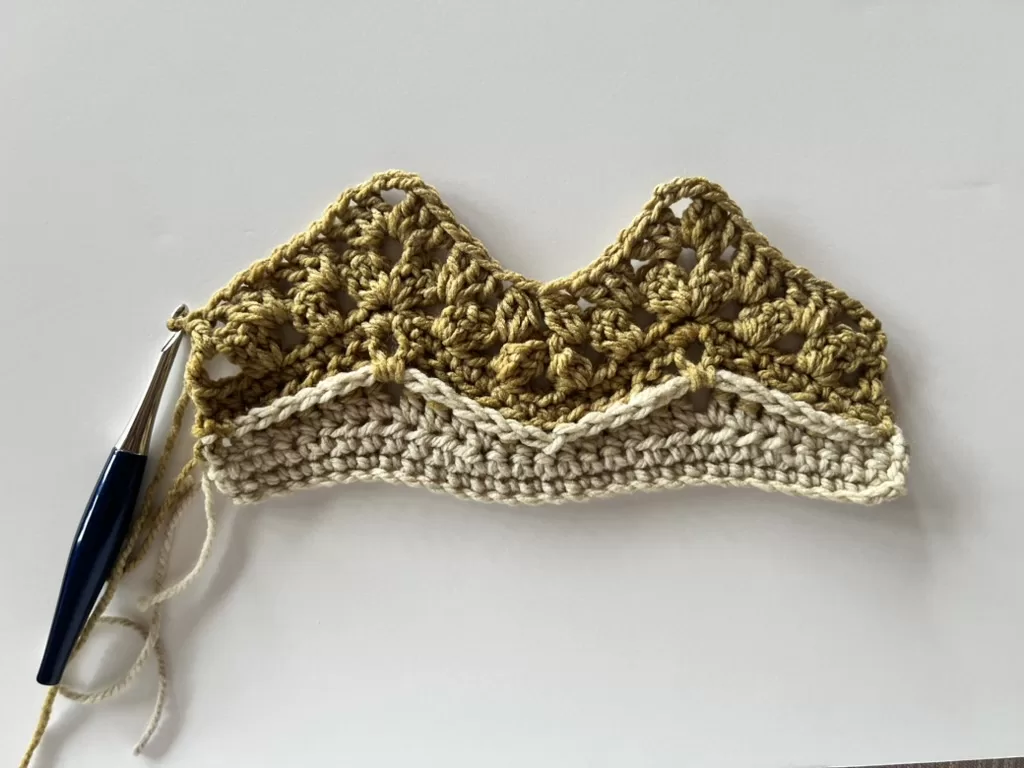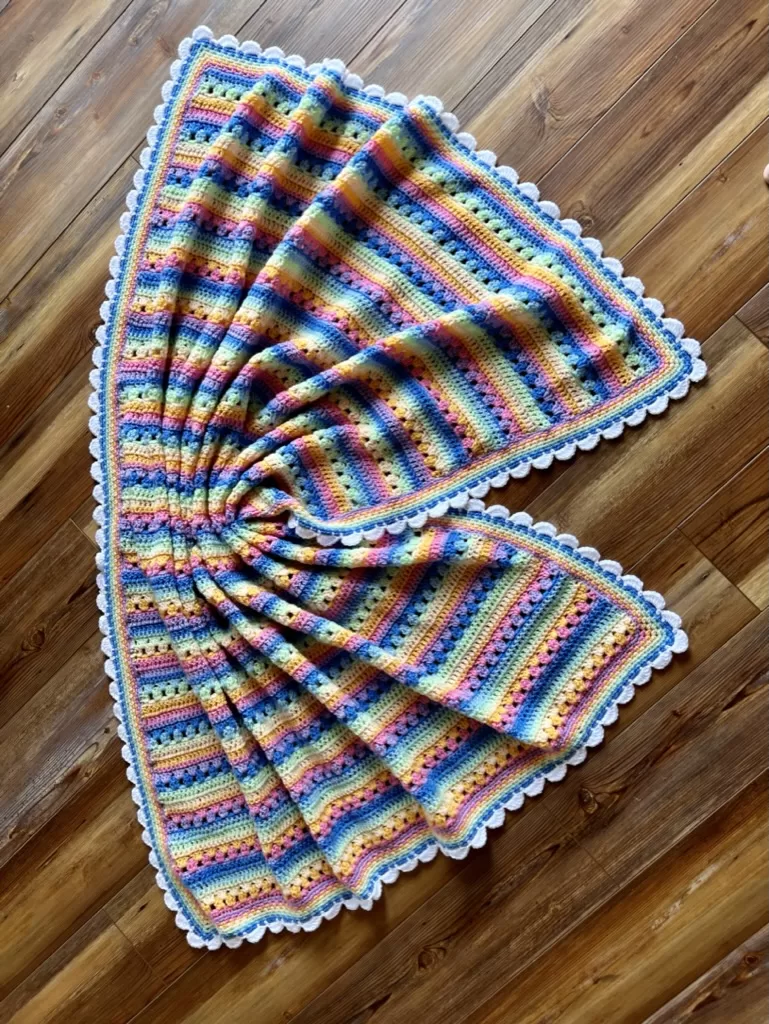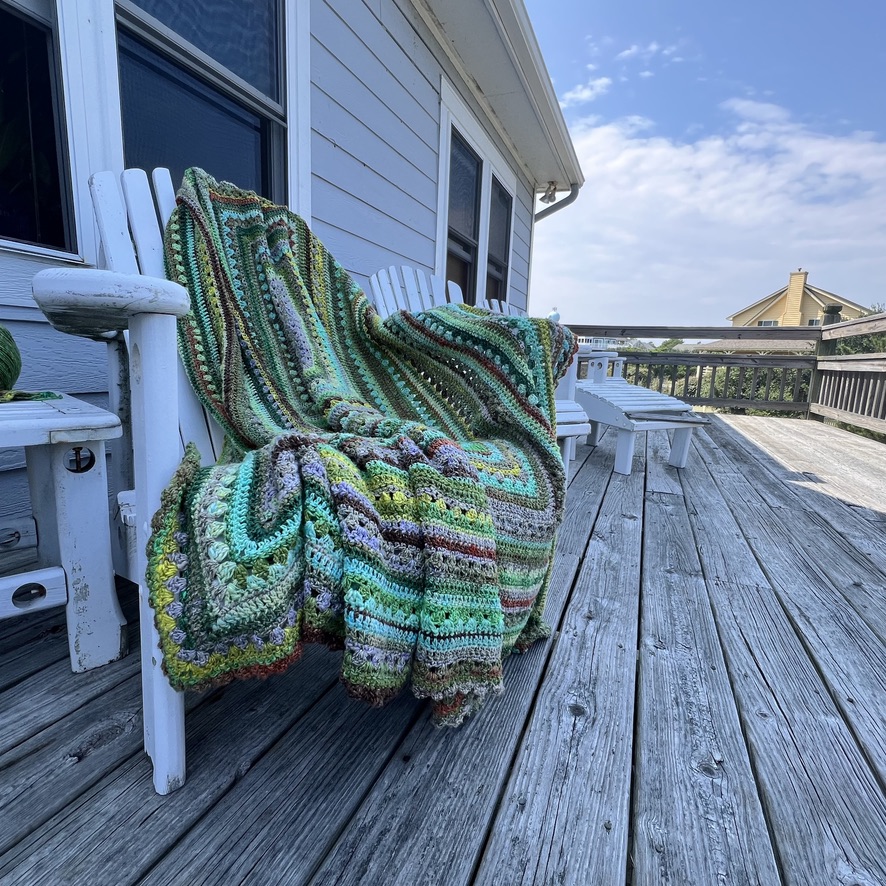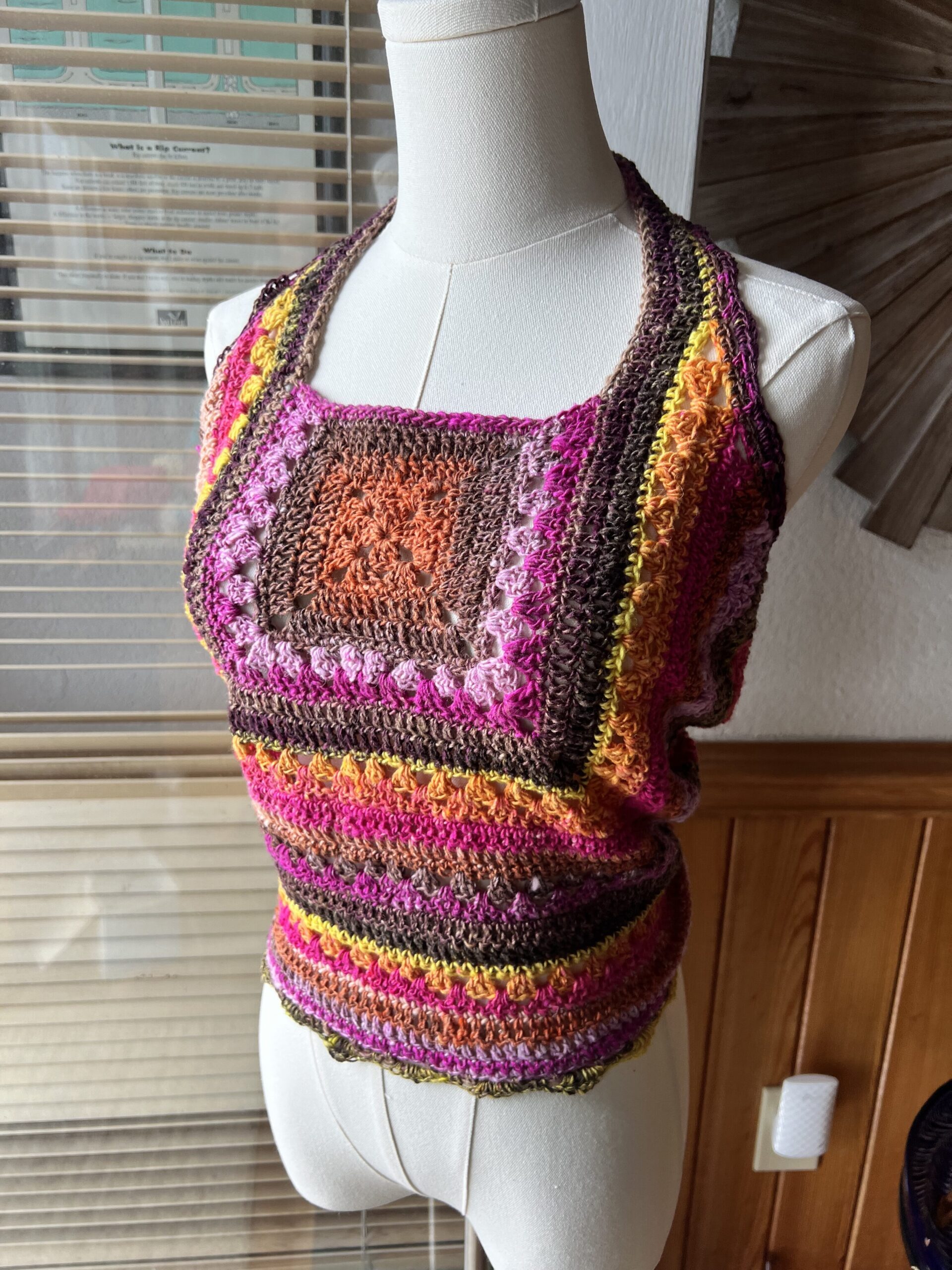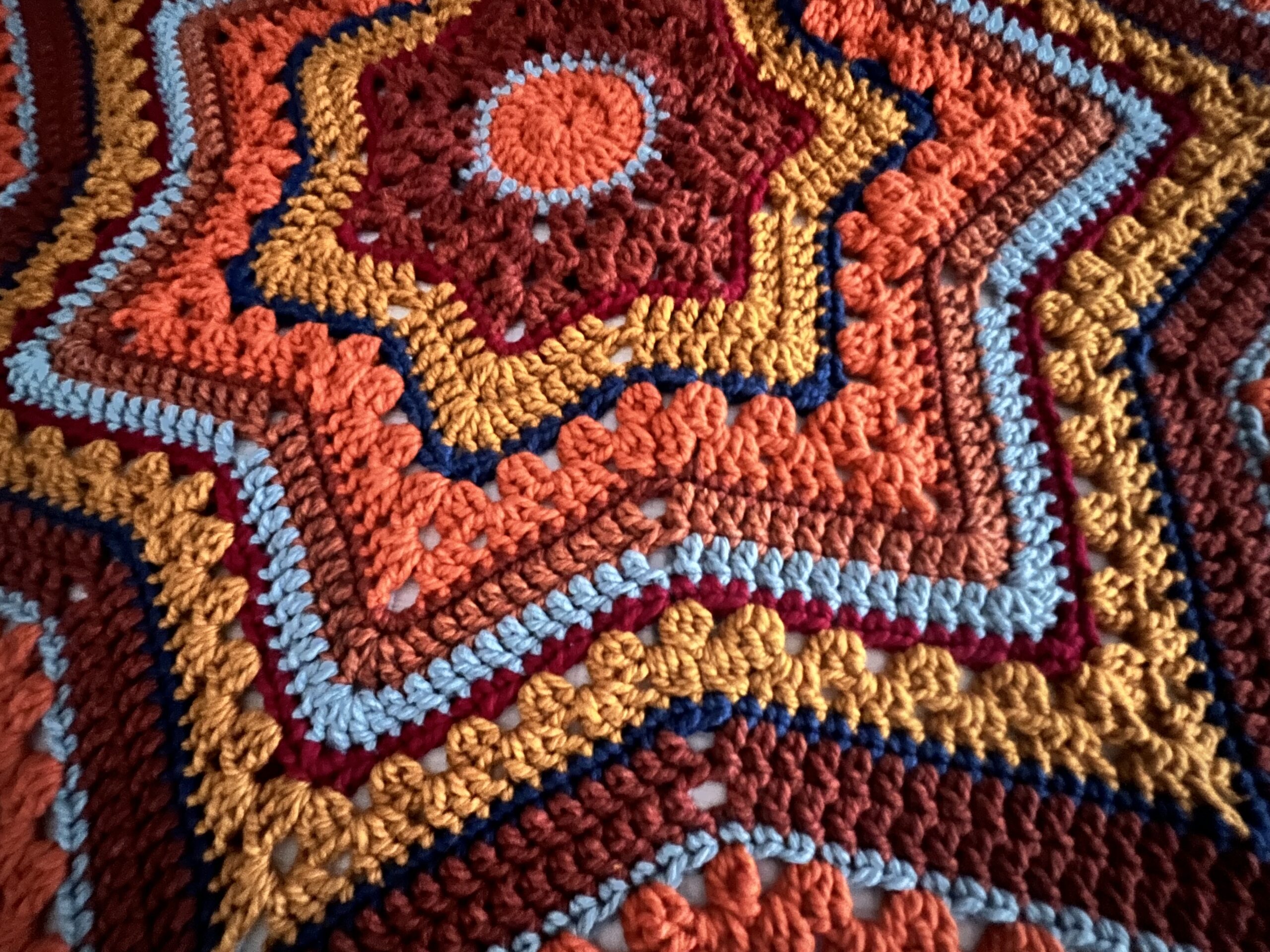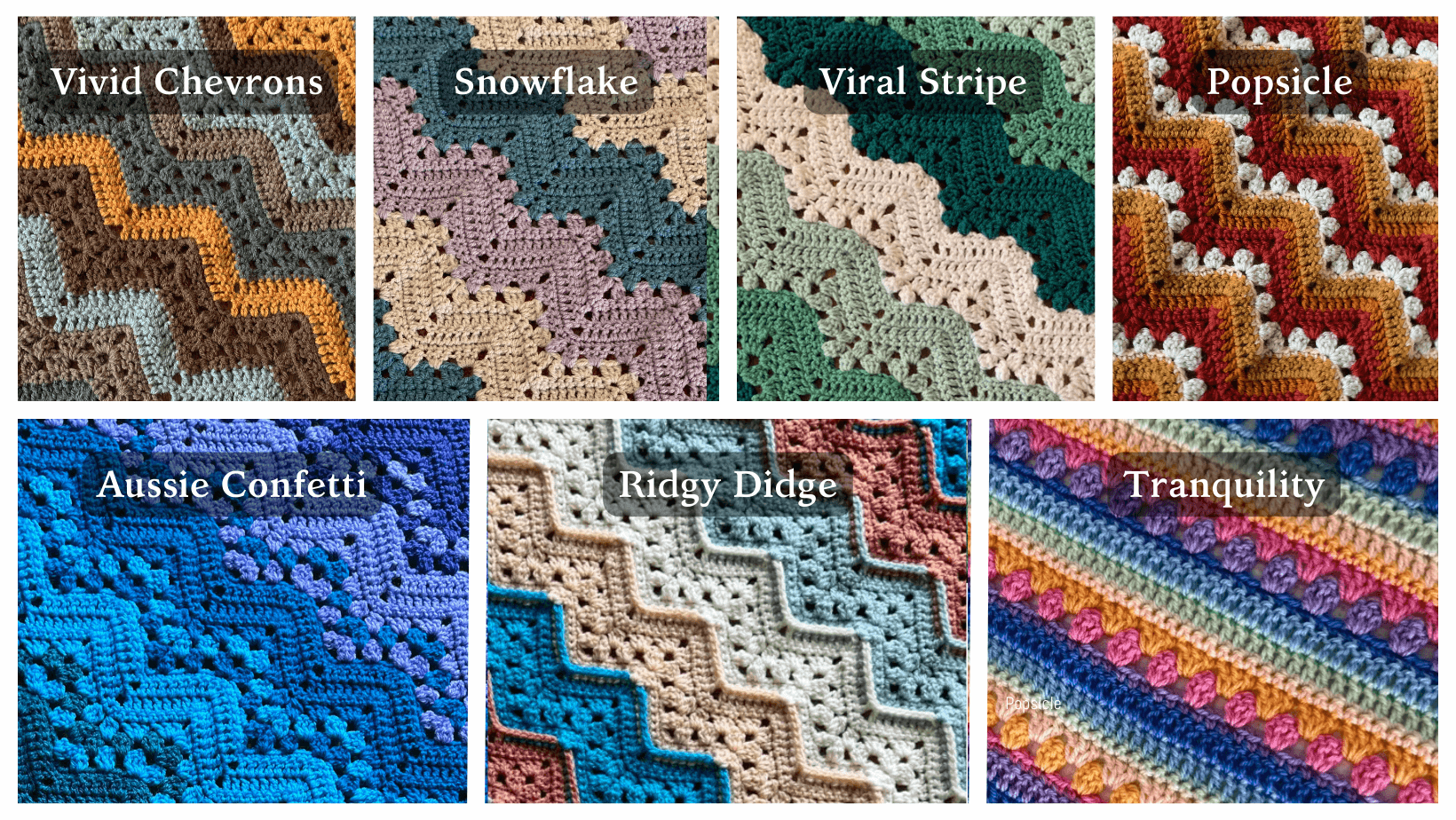Changing Colors on the 6DKB – The Snowflake Effect
Stay in touch! Sign up for Betty’s Newsletter.
Snowflake Effect
Pattern by Betty McKnit
color concept by Unknown Crocheter
There are infinite possibilities for color changes for the 6-Day Kid Blanket. Depending on your color choices and how you stripe your blanket (or don’t!) this pattern can take on many different looks. See my article “No Two 6-Day Kid Blankets are Alike” for information about all the popular ways to stripe the 6-Day Kid Blanket.
The Snowflake Effect
By changing colors between the two “granny rows” (rows 2 and 3) of the 6-Day Kid Blanket pattern you will create a wide stripe with texture on both sides of the stripe. This is the effect we call the Snowflake Effect.
This is a very popular look for the 6-Day Kid Blanket and one that many crocheters ask how to achieve.
This is a Recipe
This is a RECIPE for a 6-Day Kid Blanket in the Snowflake Effect. I will give you the stitches and tell you when to change colors, but you will need to choose your own yarn in two or more solid colors, decide what size blanket you would like, make a swatch and figure out how many points and starting chains you will need, decide how long your blanket will be and figure out how many stripes you will need to make, and also figure out your own yardage.
Use the chart at the end of this pattern and my YouTube video for resizing.
If you need a pattern that will tell you exactly what to do, you can follow the 6-Day Baby Girl Blanket pattern which is a baby blanket size in #3 DK weight yarn, written in Snowflake Effect with five colors of gorgeous Nurturing Fibres yarn (kits sold at Good Loops Yarns) and a ruffled edge.
Important Things To Know:
First timers
If this is your first time making a 6-Day Kid Blanket, before you begin, I suggest you make a swatch on 37 chains while following along with my video tutorials on my YouTube Channel. I know you probably never swatch and will be tempted to bypass this advice, but take my word for it. The first few rows are a little tricky and you’ll sidestep common mistakes and avoid the frustration of frogging hours of hard work by swatching along with my tutorials before starting your blanket.
On top of the stitch combinations and counts having a steep initial learning curve, the Snowflake Effect is a little confusing because the colors do not change with the stitch repeat. If this is your first 6DKB, keep swatching until you understand the stitches and the color changes. Join my Facebook group if you need help.
Stripe Symmetry
This striping method does not follow the pattern repeat, and the pattern ends with a 1/2 repeat. You will end up with a narrow stripe at the top and bottom of the blanket consisting of rows 1 and 2 on the bottom and rows 3 and 4 on top. Please plan ahead, especially if you plan to use more than two colors, for these stripes to match each other and the first round of your border
Remember that making a swatch is the BEST way to learn the stitches and to try out different color combinations and stripe options. There are other great reasons to swatch, so be sure you do!
Side edges:
Some crocheters have had issues with the side edges of their blankets curling. Here are some steps you can take to help alleviate this:
- ch 4 at the beginning of the row where the instructions say to ch 3. This is something you should try in your swatch, as some crocheters with tighter tension find that they really do need that extra stitch. Others do fine without it.
- Replace the dc at the end of each row with extended double crochet (edc)
Keep in mind when adding additional stitches on the edge you may need to skip stitches when working along the sides to get your edges to lie flat. There is no exact formula for how many sc to work into the edge. Use your judgement and lay it down often and check it as you are working.
- When working the last stitch of the row, insert the hook from back to front, instead of from front to back.
- Work an edge into the turning chains and sc/dc stitches on the sides of the work as described at the end of this pattern, rather than into the spaces.
- Wash your blanket once it is complete, and lay it out flat to dry, gently stretching and shaping the edges.
Changing Colors:
To change yarns on color changes, draw the new color through the last two loops of the last stitch of the row before the color change.
Creating a straight top and bottom edge:
This version creates a chevron top and bottom edge. If you would like a straight top and bottom edge, you will have to make alterations not given in this pattern. Please see my website articles “How to start your 6-Day Kid Blanket with a Straight Edge” and “6DKB Straight Start Questions Answered.” Be sure to account for extra yardage, and also stripe symmetry.
Does it really only take 6 Days to make?
It’s definitely possible! The original 6-Day Kid Blanket was toddler sized made with chunky weight yarn. I have found though that if your blanket starts with 123 or fewer chains it can be done in 6 days. Any more and you will need to give yourself more time.
Finished Size: varies, see chart
Skill Level: Easy
Yarn: two or more colors, yardage divided evenly between colors with additional yardage for border.
This isn’t a good variation for cake yarn. Try Betty’s Lazy Mixer, Spring Mixer, Mushroom Risotto, or Boom Blanket.
Yardage: varies, see chart
Hook: make a swatch to determine the best hook for your yarn
Gauge: varies
Abbreviations:
ch: chain
dc: double crochet
dc3tog: (NOT TO BE CONFUSED WITH dec dc3tog).
Work dc3tog into one stitch – not over three stitches
[yarn over, pull up a loop, pull through two loops] 3 times. Yarn over, and pull through all 4 loops on the hook. (Be sure to pull up a loop in the same stitch every time.) dc3tog complete.
rep: repeat
sc: single crochet
sk: skip
sp(s): space(s)
Begin the pattern
With your first color, ch chain a multiple of 17 + 3
Row 1: (RS) 1 sc into 2nd ch from hook, 1 sc into each ch to end.
Turn
Row 2: ch 3, sk first 3 sc (the sc on the end of the row, the one below your turning chain counts as 1)
[3dc in next sc, sk next 2 sc] twice, [3 dc, ch 3, 3 dc] into next sc
*sk next 2 sc, 3dc into next sc, sk next 2 sc, dc3tog
sk next 4 sc, dc3tog, sk next 2 sc, 3 dc in next sc, sk next 2 sc
[ 3 dc, ch3, 3 dc] into next sc; rep from * to last 9 sc
sk next 2 sc [3 dc into next sc, sk next 2 sc] twice, 1 dc into last sc.
Turn
Change to the next color.
To change yarns on color changes, draw the new color through the last two loops of the last stitch of the row before the color change.
Row 3: ch 3, sk sp between turning ch and next 3-dc group, 3 dc into each of next 2 sp
[3dc, ch3, 3dc] into next ch-3 sp
*3 dc into next sp, dc3tog into next sp
sk next sp, dc3tog into next sp, 3 dc into next sp, [3dc, ch3, 3dc] into next ch- 3 sp
rep from * to last 3 sps, 3 dc into each of next 2 sps
1 dc into sp between last 3 dc group and turning ch.
Turn
Row 4: ch 1, sc into first dc of the row (the one right below your turning chain)
sk next dc, 1 sc into each of next 8 dc
*3 sc into next ch 3 sp, 1 sc into each of next 14 sts
repeat from * to last ch-3 sp, 3 sc into last ch-3 sp
1 sc into each of next 8 dc, sk next dc, 1 sc into 3rd st of ch 3.
Turn
Row 5: Ch 3, sk first 2 sc of the row below (the sc your turning chain is coming out of counts as the first one). 1 dc into each of next 8 sc
*3 dc into next sc (you should be working these into the center stitch of the 3 sc. If not, you may have skipped incorrectly in the beginning of the row.) 1 dc into each of next 7 sc
sk next 2 sc, 1 dc into each of next 7 sc
rep from * to last 11 sc, 3 dc into next sc, 1 dc into each of next 8 sc
sk next 2 sc, 1 dc into the turning chain from the row below.
Turn
Row 6: Ch 3, sk first 2 dc in the row below (the dc below your turning chain counts as 1)
1 dc into each of next 8 dc
*3 dc into next dc (you should be working into center stitch of 3 dc)
1 dc into each of next 7 dc, sk next 2 dc, 1 dc into each of next 7 dc
rep from * to last 10 dc
3 dc into next dc, 1 dc into each of next 8 dc, sk last dc, 1 dc into 3rd st of ch 3, turn.
Row 7: Ch 1, sc into first dc (the same one the turning chain is coming out of), sk 1 dc
1 sc into each dc along row to last dc
sk last dc, 1 sc into 3rd ch of ch 3, turn.
Repeat rows 2-7 working color changes as follows: Row 2 – Continue with your second color. Row 3 – change to the next color in your sequence, and continue through Row 7 and also Row 2 of the following repeat before changing colors. Change colors before each row 3.
Continue to desired length, and then:
Repeat rows 2-4 one time more time, working row 2 in the same color as the previous repeat, and rows 3 and 4 in the next color of your sequence (hopefully you planned ahead and these last two rows match your first two rows). The blanket ends on Row 4.
Finishing:
You can add whatever type of border you like to this blanket. Begin with a base round of single crochet as follows first.
Edge Row 1
Work a row of sc around the blanket, working 3 sc into each point along the corners and top and bottom of the blanket.
When working sc into the sides of the blanket, use the turning chains and the dc stitches as foundation chains, working under 2 threads of each stitch and leaving one thread below. This creates a beautiful even edge to the work.
Complete with the edge of your choice.
Weave in all ends.
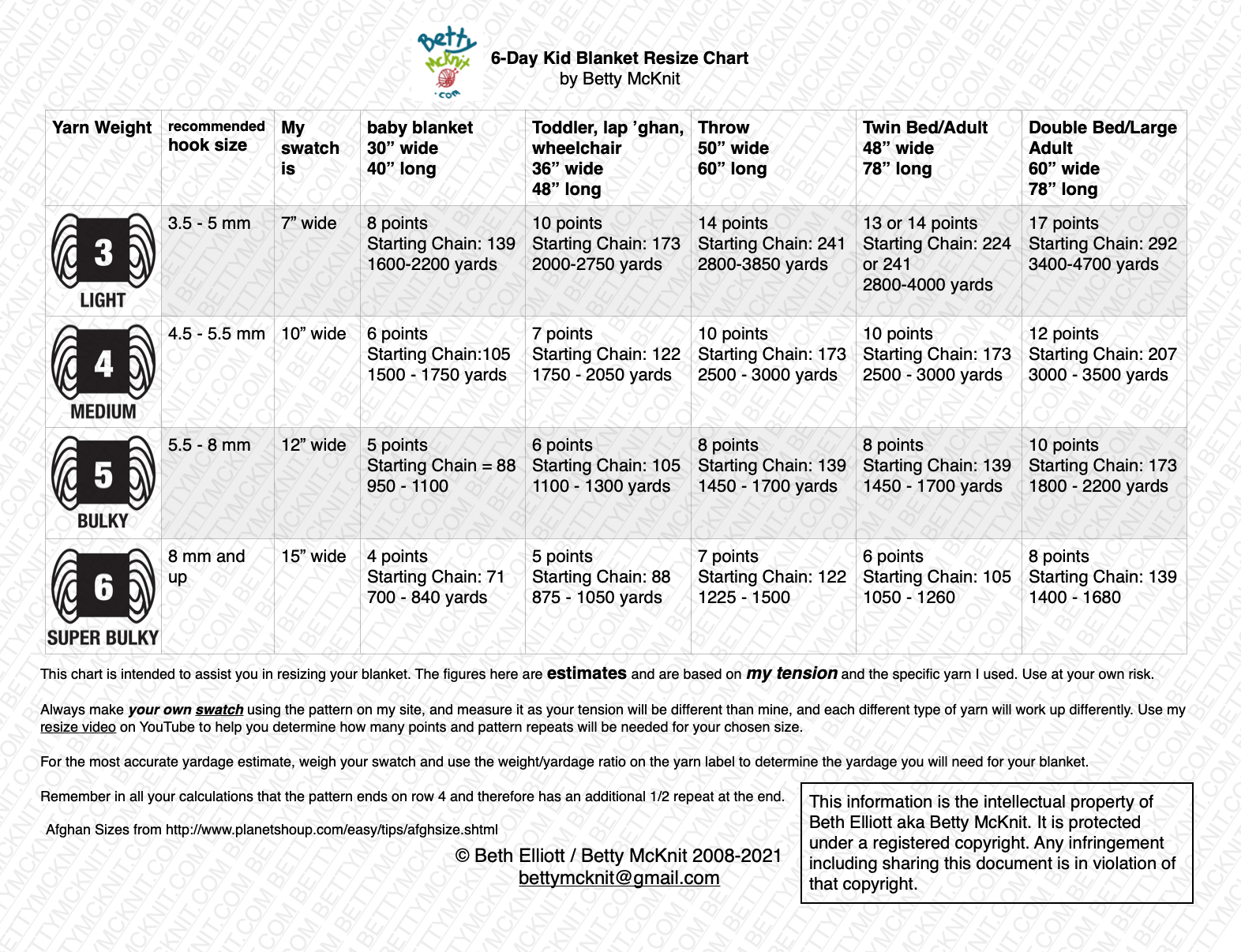
Join us in the 6-Day Kid Blanket Facebook Group
Video tutorials available at
http://tinyurl.com/6DayKidBlanket
This pattern is the intellectual property of Betty McKnit/Beth Elliott, and it is protected by copyright. Publishing corrections, translations, written or video tutorials, or variations of this pattern, online or elsewhere, without written permission from the owner is a violation of copyright.
The stitch pattern is “Vivid Chevrons” #110 from 200 Ripple Stitch Patterns by Jan Eaton.
Reprinted with permission from Quarto Publishing.
Thank you to the unknown crocheter who came up with the creative idea to change colors on different rows and create this popular effect.
This pattern contains affiliate links.
Disclaimer: This site contains affiliate links.
Stay in touch! Sign up for Betty’s Newsletter.

